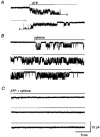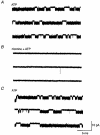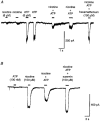Mutual occlusion of P2X ATP receptors and nicotinic receptors on sympathetic neurons of the guinea-pig
- PMID: 9660893
- PMCID: PMC2231072
- DOI: 10.1111/j.1469-7793.1998.783bj.x
Mutual occlusion of P2X ATP receptors and nicotinic receptors on sympathetic neurons of the guinea-pig
Abstract
1. The interaction of ion channels activated by nicotinic receptor agonists with ion channels gated by extracellular ATP (i.e. P2X receptors) was studied on sympathetic neurons acutely dissociated from coeliac ganglia of the guinea-pig. Patch clamp methods were used to measure the inward current generated through these non-selective cationic channels under voltage clamp. 2. At the whole cell level, the specific nicotinic receptor agonists nicotine (5-100 microM) or cytisine (50-75 microM) and the P2X receptor agonists ATP (0.1-7 microM) or alpha,beta-methylene ATP (6 microM) were examined separately and in the presence of the other receptor activator. When a nicotinic and P2X receptor agonist were applied together, mutually occlusive effects were generally observed. This occurred even with concentrations of agonists that in themselves generated little to no inward current. 3. The occlusive effects of nicotinic agonists on ATP-gated currents were blocked by the nicotinic receptor/ion channel blocker hexamethonium (150 microM). The occlusive effects of ATP analogues on inward currents generated by nicotinic agonists were blocked by the P2X receptor antagonist suramin (100 microM). 4. Mutual occlusion of the effects of nicotinic agonists and ATP analogues were also observed when currents through single channels were studied in excised (outside-out) patches. 5. The results suggest that nicotinic receptors and P2X ATP receptors do not act independently in these sympathetic neurons.
Figures






Similar articles
-
Functional interactions between nicotinic and P2X channels in short-term cultures of guinea-pig submucosal neurons.J Physiol. 1998 Dec 15;513 ( Pt 3)(Pt 3):671-83. doi: 10.1111/j.1469-7793.1998.671ba.x. J Physiol. 1998. PMID: 9824709 Free PMC article.
-
Non-additive interaction between nicotinic cholinergic and P2X purine receptors in guinea-pig enteric neurons in culture.J Physiol. 1998 Dec 15;513 ( Pt 3)(Pt 3):685-97. doi: 10.1111/j.1469-7793.1998.685ba.x. J Physiol. 1998. PMID: 9824710 Free PMC article.
-
P2x-purinoceptors of myenteric neurones from the guinea-pig ileum and their unusual pharmacological properties.Br J Pharmacol. 1996 Dec;119(8):1541-8. doi: 10.1111/j.1476-5381.1996.tb16070.x. Br J Pharmacol. 1996. PMID: 8982499 Free PMC article.
-
Functional properties of native and cloned P2X receptors.Ciba Found Symp. 1996;198:208-19; discussion 219-22. doi: 10.1002/9780470514900.ch12. Ciba Found Symp. 1996. PMID: 8879827 Review.
-
ATP as a cotransmitter in perivascular sympathetic nerves.J Auton Pharmacol. 1996 Dec;16(6):337-40. doi: 10.1111/j.1474-8673.1996.tb00048.x. J Auton Pharmacol. 1996. PMID: 9131411 Review.
Cited by
-
Neuromodulation by extracellular ATP and P2X receptors in the CNS.Neuron. 2012 Oct 4;76(1):51-69. doi: 10.1016/j.neuron.2012.09.024. Neuron. 2012. PMID: 23040806 Free PMC article. Review.
-
Intracellular cross talk and physical interaction between two classes of neurotransmitter-gated channels.J Neurosci. 2003 Feb 15;23(4):1246-53. doi: 10.1523/JNEUROSCI.23-04-01246.2003. J Neurosci. 2003. PMID: 12598613 Free PMC article.
-
Methyllycaconitine, alpha-bungarotoxin and (+)-tubocurarine block fast ATP-gated currents in rat dorsal root ganglion cells.Br J Pharmacol. 2004 Aug;142(8):1227-32. doi: 10.1038/sj.bjp.0705878. Epub 2004 Jul 26. Br J Pharmacol. 2004. PMID: 15277311 Free PMC article.
-
Activation of cholinergic receptors blocks non-adrenergic non-cholinergic contractions in the rat urinary bladder.Brain Res Bull. 2008 Dec 16;77(6):420-6. doi: 10.1016/j.brainresbull.2008.07.011. Epub 2008 Aug 26. Brain Res Bull. 2008. PMID: 18755252 Free PMC article.
-
A possible role of the cholinergic and purinergic receptor interaction in the regulation of the rat urinary bladder function.J Muscle Res Cell Motil. 2012 Mar;32(6):421-31. doi: 10.1007/s10974-012-9285-x. Epub 2012 Feb 28. J Muscle Res Cell Motil. 2012. PMID: 22370867
References
-
- Albuquerque EX, Alkondon M, Pereira E, Castro NG, Schrattenholz A, Barbosa TF, Bonfante-Cabarcas R, Aracava Y, Eisenberg HM, Maelicke A. Properties of neuronal nicotinic acetylcholine receptors: Pharmacological characterization and modulation of synaptic function. Journal of Pharmacology and Experimental Therapeutics. 1997;280:1117–1136. - PubMed
-
- Bean BP. Pharmacology and electrophysiology of ATP-activated ion channels. Trends in Pharmacological Sciences. 1992;13:87–90. - PubMed
-
- Brake AJ, Julius D. Signalling by extracellular nucleotides. Annual Review of Cell and Developmental Biology. 1996;12:19–41. - PubMed
-
- Buell G, Collo G, Rassendren F. P2X receptors: an emerging channel family. European Journal of Neuroscience. 1996;8:2221–2228. - PubMed
Publication types
MeSH terms
Substances
Grants and funding
LinkOut - more resources
Full Text Sources

